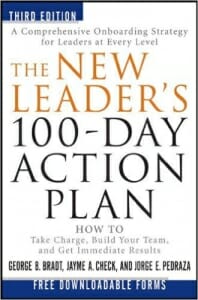 The New Leader’s 100-Day Action Plan: How to Take Charge, Build Your Team, and Get Immediate Results, written by George Bradt, Jayme Check and Jorge Pedraza, is a book about helping executives succeed in transition. The layout is roughly as follows:
The New Leader’s 100-Day Action Plan: How to Take Charge, Build Your Team, and Get Immediate Results, written by George Bradt, Jayme Check and Jorge Pedraza, is a book about helping executives succeed in transition. The layout is roughly as follows:
- Landing a great position through the interview process.
- Utilizing the time between acceptance and “Day One” strategically.
- Planning what an executive should (and shouldn’t) actually do in the first hundred days.
The first section helps the reader understand what positions would be a good “fit” for a particular executive. In other words, it is about understanding who a person really is, and finding the intersection of passion and competency. From this point, a pragmatic (win first!) strategy is laid out to “ace the interview” and receive an offer. The point is made several times that there are only three types of interview questions: strengths, motivation, and fit. Correspondingly, there are only three kinds of answers. The sections on negotiation (post offer and prior to acceptance) and determination (if one should actually accept a particular offer) are worth the price of admission in and of themselves.
The second section is about leveraging the time between acceptance of the position and the first day in the position. The point is repeatedly made that the strategic use of this time is often ultimately the difference between success and failure. It is actually prior to the first day that the new leader should make strategic connections and map out their message and hundred-day plan. During this time, the executive should also ensure that everything is already set up and ready with his/her office so that it is completely ready on the first day.
The final section is what the reader likely originally expected: a blueprint of the first hundred days. There is a detailed focus on how to leverage the first day, as well as how to achieve early wins and develop timelines with achievable milestones. There are sections on how one’s message is communicated, as well as a focus on aligning/rearranging one’s new team for success.
This hundred day process is summarized by the following:
- Leverage the “fuzzy front end.” This is the time post acceptance of the position and prior to your first day. This period is not for finishing your last job well or for rest. Instead, this time must be used strategically to prepare for your next position.
- Take control of Day One. One must know exactly what they should and shouldn’t be doing on this most important of days. Hint: It is not for setting up your office or spending the majority of your day with HR.
- Embed a “Burning Imperative.” The “Burning Imperative” is your ceaseless message (beginning prior to Day One!) which will bring your team together and clearly and concisely communicate where you are leading them.
- Invest in early wins. One must work much harder than normal to secure one or more significant achievements by Day 60. This instills confidence in your team and impresses the brass and your peers that you can deliver.
- Secure “adept” people in the right roles. It is important to not be afraid to change your team to achieve your desired results—this is best done sooner rather than later. Some may need to be let go, others need a different role. This not only optimizes your team, but shows them you mean business.
- Evolve people, plans, and practices. This involves moving forward through your timeline to take your team to where you are leading them.
It is important to note that the title of this work may lead some readers astray. This book is not at all for people who are new to leadership in general. Instead, it is written to savvy, veteran executives in the corporate world who are transitioning to a new role in another company (or a new role within their present company). This work is unapologetically written to executives who want to maximize their chances to succeed and minimize their chances to fail.
The tone of this book does not surprise. From the beginning, a bedrock statistic is given that forty percent of executives “fail” within the first eighteen months. Failure is defined as being fired, forced into resignation, or quitting. The authors then claim that by following their advice, an executive can cut that rate to below ten percent.
Though not totally reminiscent of Machiavelli’s “The Prince” or Sun Tzu’s “The Art of War,” there are some similarities in tone. Cold-blooded corporate political advice is doled out in generous scoops. Though never stated, the reader will become convinced that the authors absolutely believe that “business is war.”
There also seems to be an underlying philosophy that new executive positions are often involved in zero sum games: There will regularly be winners and losers when leaders transition, and one must be forewarned and forearmed for the battles to come. In other words, despite tired corporate jargon of “synergy” and “breaking down silos” there will always be incumbent peers and direct reports who will fear the change any new executive brings. Indeed, the new leader must bring change … which will necessarily challenge the status quo … which will necessarily cause others within the organization to oppose this new leader.
At the end of the day, a new leader would be well advised to read and heed much of the advice of this book. It reminds me of when Jesus said, “Therefore be as shrewd as snakes and as innocent as doves” (Matt. 10:16). Certainly, this book falls into the “shrewd as snakes” category. One can wish life in church leadership weren’t like this, but all too often it can be similar. The reason is that people in the church (as well as pastors) are still human, and often times just as sinful as corporate executives. One realizes that this book ultimately deals in human nature as much as a particular setting.
A key difference is that, as pastors, we are not “at war” with the church—we are to love Her as we love Christ. The ultimate goal of a pastor is not position/power/money, but instead to selflessly allow the Holy Spirit to work through us to help the local Body become more healthy. We pursue the Great Commission, which doesn’t change, through methods which must always be changing. Though any course of action one chooses will be opposed, the XP/SP must never forget that those who oppose change are not enemies, but are people for whom Jesus also died.
Given the similarly high instance of pastors “failing” within eighteen months, a new XP/SP would be well advised to have a strong hundred-day action plan. Ultimately, there is much to gain (and some to be left) in this book, and I strongly recommend it for all XPs, as well as for transitioning SPs.











